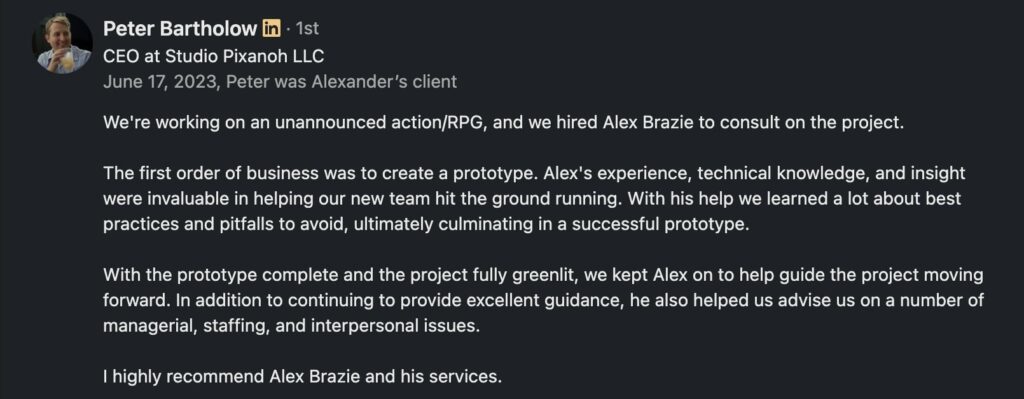Open-world game design is an effective option for immersing players and keeping them engaged in the long term, as decades of the genre’s history since early franchises like Ultima have shown. Open-world games lend themselves to a variety of other genres: RPGs, survival games, sandbox games, and immersive sims. Each genre further ranges from a procedurally generated game with no boundaries to a tightly designed, hand-crafted experience. The former, generated type favors organic, environmental storytelling while a hand-crafted game presents a complex story for the player.
Consider what the core loop looks like and which type of open-world game it fits at the beginning. With an idea of the target experience in mind, design each area to feel unique, draw in the player, and guide them effectively. Making a game unique and fun also requires understanding the variety of verbs the player has access to, how they navigate the world quickly, and the strategies the game uses to communicate its world and themes, so learn towards the end of the article how to keep the player immersed. Read on for a set of steps that take you from an idea to an open-world game that fits your design idea.
1. Understand the different types of open-world games
Understanding the different types of open-world games is step one to building your target experience. Open-world games fall into three bins: completely procedural worlds, “puzzle-piece” worlds that are a mixture of hand-crafted pieces and procedurally generated areas, and completely hand-crafted worlds. All open worlds have a series of points of interest (POIs) that the player moves between as well, and these come in two types in turn.
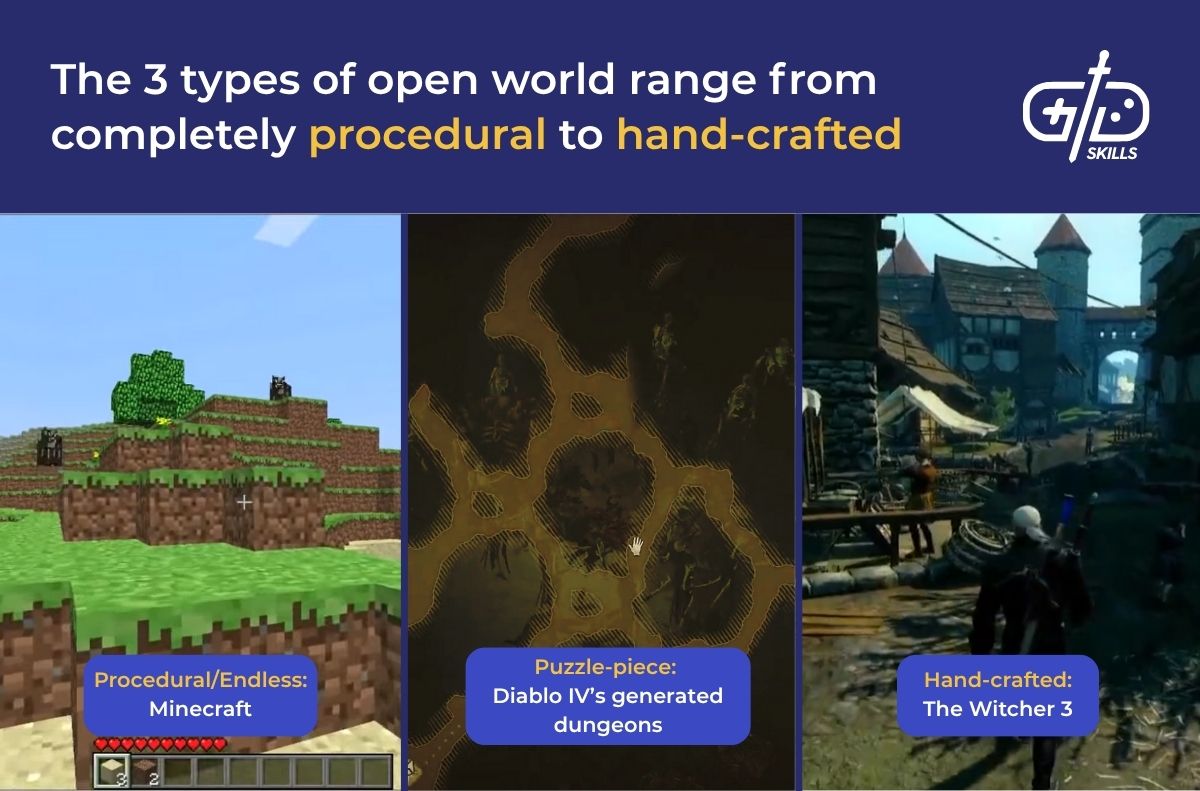
The choice between player-driven storytelling and hand-crafted narrative is going to affect which of the three worlds to use. A game about boundless creativity like Minecraft puts no limits on exploration, but it doesn’t have a complex or engaging story. The other two types are hand-built to create a curated response in the player. Diablo IV contains randomly generated dungeons, but the story and explorable overworld give the player context and motivates them to fight and earn better gear.
An advantage of procedural generation over a completely hand-crafted experience is replayability. Open-world games are great for longevity because so much of the content is likely to go unseen on a first playthrough. Procedural generation guarantees something new. Player skill is also unlikely to make the game world obsolete. Once a player has mastered the world’s challenges and seen all there is to see, there’s nothing left to persuade them to return. A highly skilled player is rewarded for their skill in a procedural game because they’re able to apply their skills in endlessly new situations. The challenge is creating a system that is engaging and meaningful, as the confusing and giant generated dungeons of Daggerfall show how easy random content becomes tedious.

Points of interest (POI) in procedural or hand-crafted games come in two types, funneled and approachable. The first directs the player to the POI. The game world narrows the path or creates only one entrance to guide the player in from a specific direction. As a result, the designer has the ability to create a more tightly controlled experience. A curated experience like the dungeons in Legend of Zelda games are classic examples.
The second type of POI is approachable from all sides. A designer needs to consider how visible the POI is from many angles, where the player’s able to enter, and playtest to make sure there aren’t game-breaking tricks for getting into the area. Outposts in the Far Cry games or Metal Gear Solid V are both examples of an approachable POI.
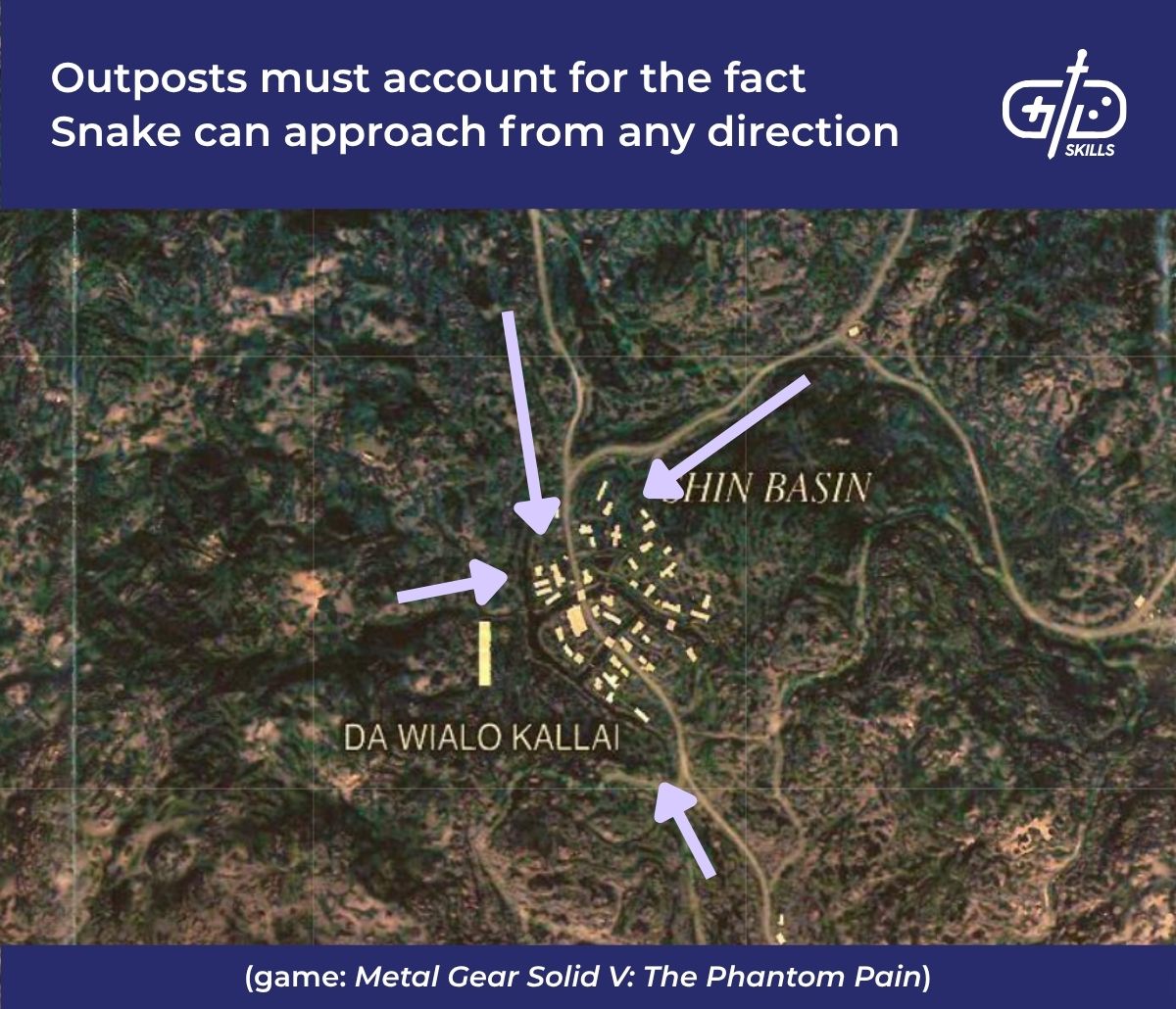
2. Define your core loop
Defining your core loop means deciding what the player actually does when playing the game, which naturally affects the design of the world. Open-world games of all types move between exploring, overcoming some challenge, and then getting the rewards for overcoming that challenge, whether they be XP, money, equipment, or just more places to explore.
A core loop is a model of the activities the player cycles through as they play. The loop creates a rhythm of play that guides the player between the different mechanics in a satisfying way. An open-world game is about freedom, but it needs challenges and rewards as well. A game all about exploration has no variation and no goals; Google Earth has exploration but isn’t a game. A gameplay loop transitions players from exploring to facing challenges to earning a reward, often one that enables further exploration.
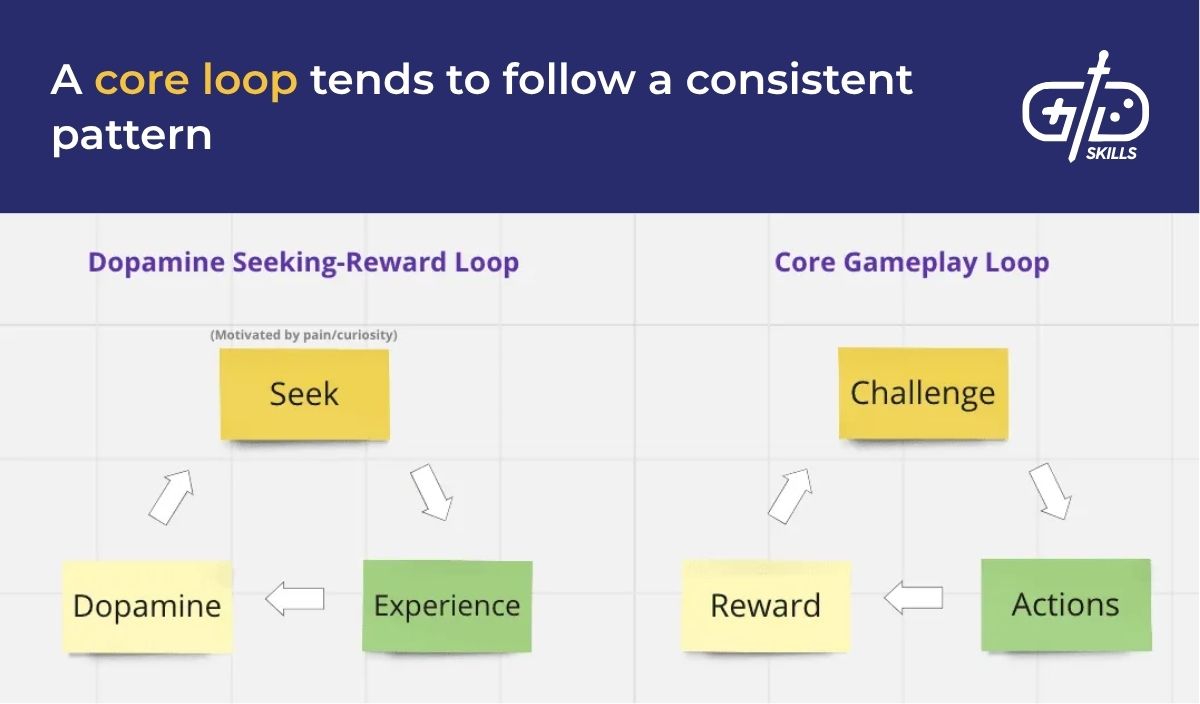
The challenge at the center of the loop is combat in most open-world games. The focus on combat isn’t completely universal: a survival game includes resource gathering, farming, and building, which is more common in a procedurally generated game. Combat is such a core part, though, because it’s present in most games and also in RPGs, which are one of the most common open-world genres.
Diablo IV has an example of a core loop that fits the mixed procedural/hand-crafted type. Players explore in order to gain better rarity loot, more gold, and XP. The loot and enemies are randomly generated, so the player is encouraged to play and replay encounters to build up their character. The combat is the challenge at the center of the loop. The game is more complex than this, but combat boils down to clicking enemies and activating abilities on a hotbar amidst a swarm of enemies. The large number of enemies in a combat encounter and management of abilities turns into a constant rhythm; the rhythm-like nature is one element that allows dungeons to be randomly generated and still deliver a satisfying experience.

Role-playing games are so common for open-worlds because the motivation to explore is built into the experience. Role-playing games task players with selecting the right attributes, skills, and abilities for navigating the game’s challenges. Classic examples are the Elder Scrolls franchise, The Witcher 3: Wild Hunt, and the Diablo franchise, but games even outside the RPG genre include role-playing mechanics to take advantage of their motivating value. Players in Red Dead 2 modify their cores (health, stamina, and dead eye) through the equipment and consumables they gain through exploration.
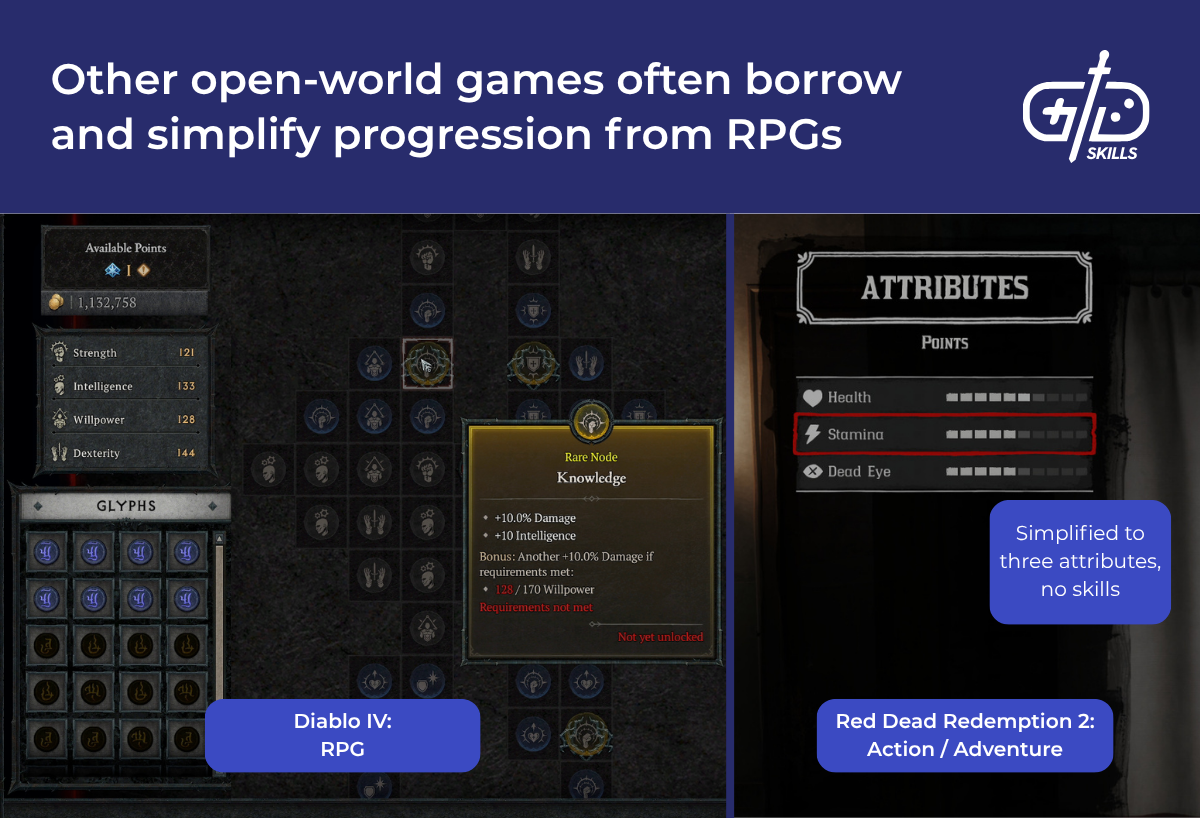
Combat isn’t the only challenge in most open-world games. Earning rewards through a variety of methods is what encourages players to explore and make interesting decisions. Minecraft is about complete creativity, for example, but playing through creative mode with no restrictions is only fun for so long. Survival mode adds basic limitations and objectives so player choice and skill has a part to play. A player needs certain resources to build what they want, and they decide between caving, farming, building devices, or trading to get what they need. The challenge that blocks player rewards then comes down to a choice between using combat, trading, mining, or farming to earn those rewards.
Another reason to establish the core loop before designing the world is because the world environment itself is often a core challenge. Survival games are the classic example with a core loop that pushes the players to find resources and build shelter in an isolated environment. Games like Death Stranding take an entirely unique, and literal, approach to making the environment a barrier. The task of the game is delivering packages, so the core challenge is moving around the environment without falling and choosing the right vehicles and tools for the job. The hilly, rugged, and mountainous terrain itself is the challenge here.
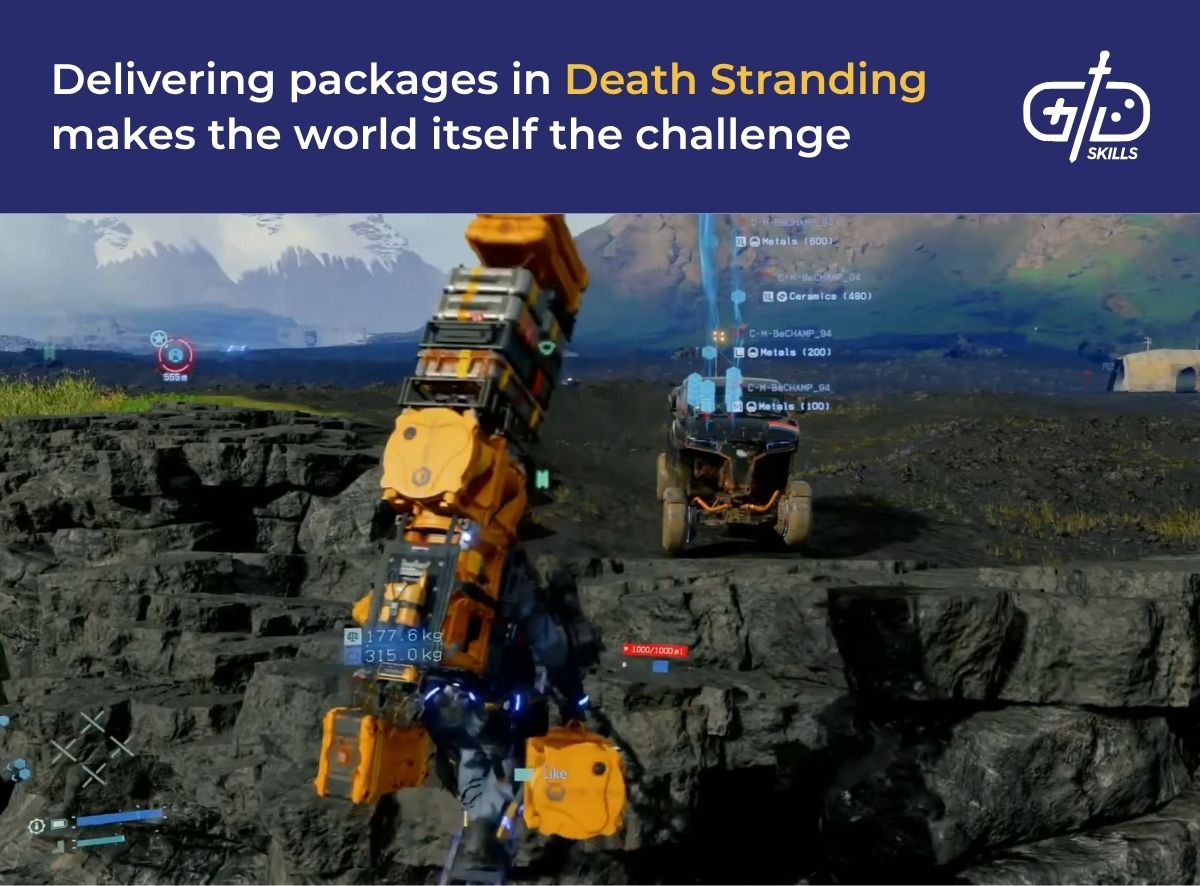
Keep in mind that exploration is only one part of the loop. Exploration is interesting, but a bad balance between exploration, challenges, and rewards results in a repetitive and boring core loop that is more likely to lose than immerse players. Exploration overtakes the other elements of a core loop in a couple ways. Few options for quick and efficient navigation force players to walk over large distances before getting to interesting content, which breaks the loop by requiring a lot of exploration for little reward. A game world without varied or interesting side content is also going to feel empty and leave much of the game time spent walking from place to place.
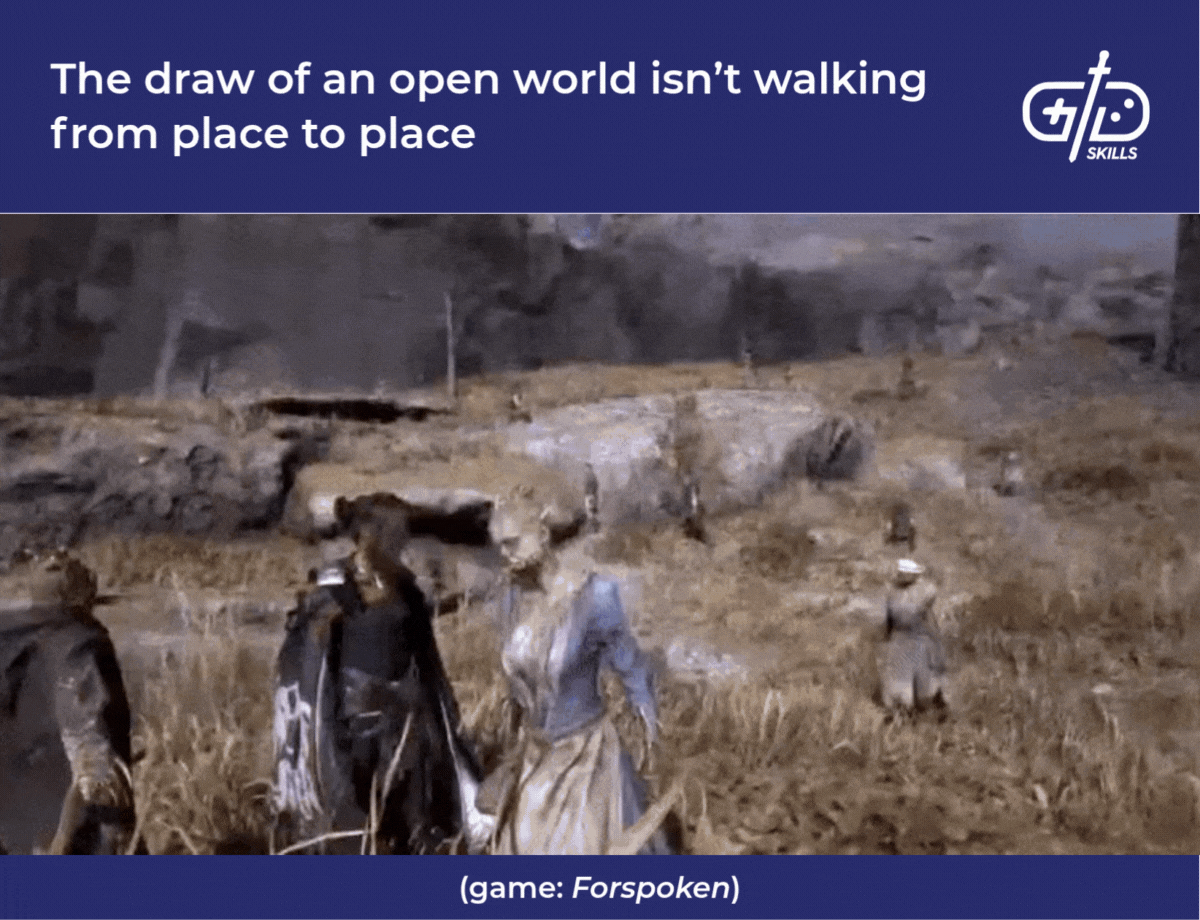
Systemic games have the potential to break down and become repetitive if they don’t involve a unique or interesting challenge in the core loop. A “systemic game” is one where much of the world isn’t pre-programmed but has a set of rules: the radiant AI in Oblivion and Skyrim are classic examples which make for a uniquely vivid world. NPCs running on Radiant AI have schedules and dialogue based on the day/night cycle, weather, and player’s actions. The radiant quests added in Skyrim are an example of a less effective system. Radiant quests are generated by these NPCs but often ask players to perform the same objectives over and over, promising unending content but providing minimal challenge. The systemic design works best in a game like Minecraft, where the entire world is generated and the player’s complete freedom is a part of the core loop in the first place.
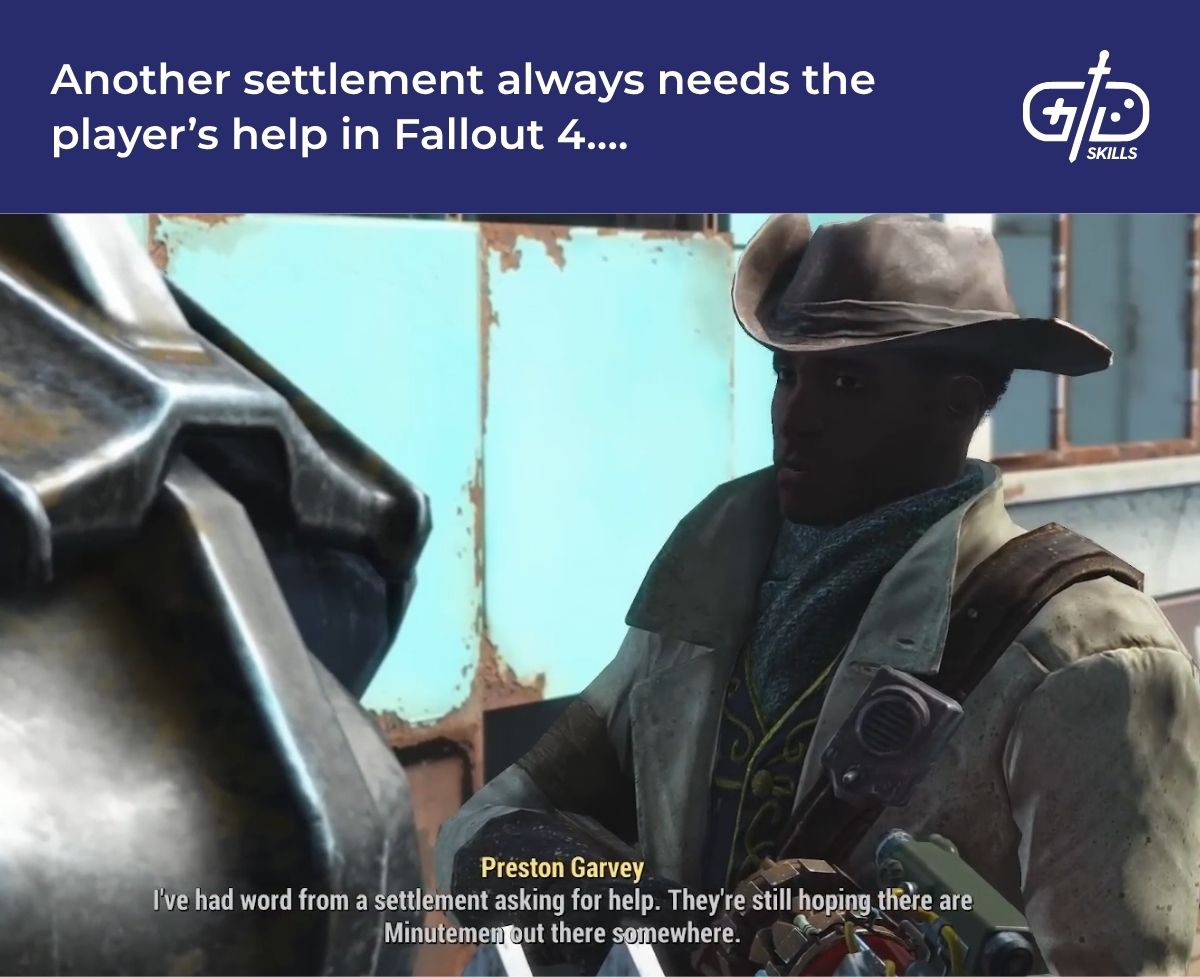
Consider whether a game with your core loop even needs an open-world. Heavily narrative-driven experiences or games with a unique core mechanic require designers to control guide players to make sure they don’t break the game. The Last of Us Part II started life as an open-world game with hubs, a big change to the previous game’s formula. The team found early on that the characters and story weren’t best served by it, since the ability to choose the next step is likely to ruin the pacing. A player always has the option to take a break from the story when they want. I think of the fact that a dragon touching down in Kynesgrove is presented as a major crisis in Skyrim, but nothing stops the player from ignoring the crisis to collect melons for 100 hours.
3. Make areas in the world feel unique
Make areas in the world feel unique to make exploration worthwhile. Unique areas create variety for the player, as performing the same action and overcoming the same challenges for the same rewards becomes boring. The advantage of an open-world game is the feeling players have that there’s always more out there to find. A unique aesthetic, new mechanics, and new challenges work together to keep the game fresh.
Making areas of the world feel unique has as much to do with gameplay and interactivity as the visual aesthetic. Forspoken is an example that’s failed to capture players with an over-ambitious but underfilled world. The side quests, called Detours, follow a couple patterns: fetch item for quest giver, chase a cat using your parkour skills, or complete dancing mini-games. The chase sequences are the only part that calls on players to use the unique mechanic of the game, parkour, and many players don’t feel they need to spend their time on detours as a result. With the game world being so large and side content so minimal, beautiful environments still struggle to engage the player.

The game needs to come to life and feel like a world for the unique areas to shine. A game full of side content and systems independent of the player does two things: it immerses the player in a lifelike world, and it gives them the impression there is a lot they missed that requires a second playthrough. Open-worlds are especially great at player retention, and Rockstar has used this fact to keep players invested in their games for years. NPCs in a game like Red Dead Redemption 2 have conversations with each other, they report your crimes when they see them, they send bounty hunters after the player. A player is only going to see a fraction of the potential NPC interactions on their first playthrough.

A unique visual aesthetic is an important ingredient for making the areas of an open-world feel unique, even if not the only one. Incentivizing players to use the mechanics and find new interactions is the core, but finding stunning new sights is a reward of its own for navigating the open-world. Ghost of Tsushima, the biggest game Sucker Punch had made up to that point, boasts 40 distinct biomes for the player to explore, some along water, others in forests, or swamps.
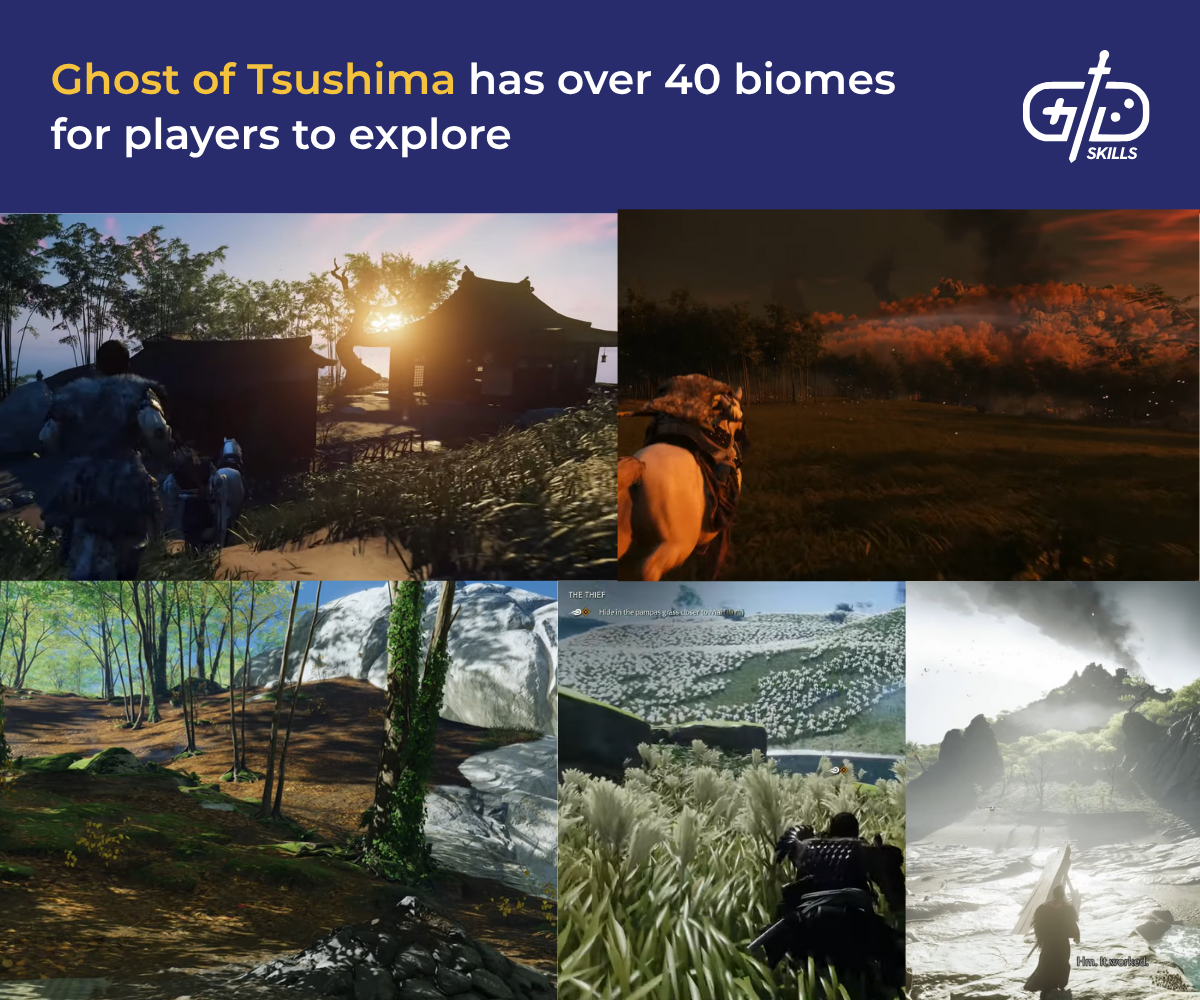
Distinguishing areas with unique mechanics means rewarding exploration with a tangible gameplay change. A new ability, method of movement, weapon, obstacle, or enemy type keeps the game fresh for the player and avoids the fatigue that sets in if they know there isn’t going to be a major change to gameplay coming up. Horizon Zero Dawn is an open-world game set in a world full of mechanical creatures that shows how to keep the gameplay fresh. The ability to hack the creatures and ride them changes the way players approach combat and exploration. Horizon Forbidden West carries the novelty across games by giving players access to flying creatures towards the end of the game, opening up areas that were inaccessible for most of the story.

Gating areas with a test of the player’s skill is a way to make regions feel unique through mechanics and not just appearance. A boss at the end of an area encourages the player to get better at the game, and also to fully explore the area before continuing to reach max power. The player feels a sense of accomplishment alongside the novelty of exploration when they beat a challenge they weren’t able to before. JRPGs such as Dragon Quest are classic examples of this strategy. Marquis de Léon in Dragon Quest IV forces this type of encounter, where the player is unable to defeat them at the castle in chapter 4, but he returns in chapter 5 to block the player’s progress, this time in a battle to the death.
New threats come with new mechanics to make exploration worthwhile. The best way to implement a new mechanic is for the mechanic to change the way the player approaches old challenges too. For example, Dying Light adds new zombie types as the player explores. After arriving at the bridge, the Bomber appears, a zombie which surprises the player and explodes after a short period. Players have the option to gain several new skills for dealing with the threat: shields are one, which prevent the player from taking full damage from the blast. Shields offer advantages against all enemies, so they’re not just a MacGuffin but a meaningful upgrade.
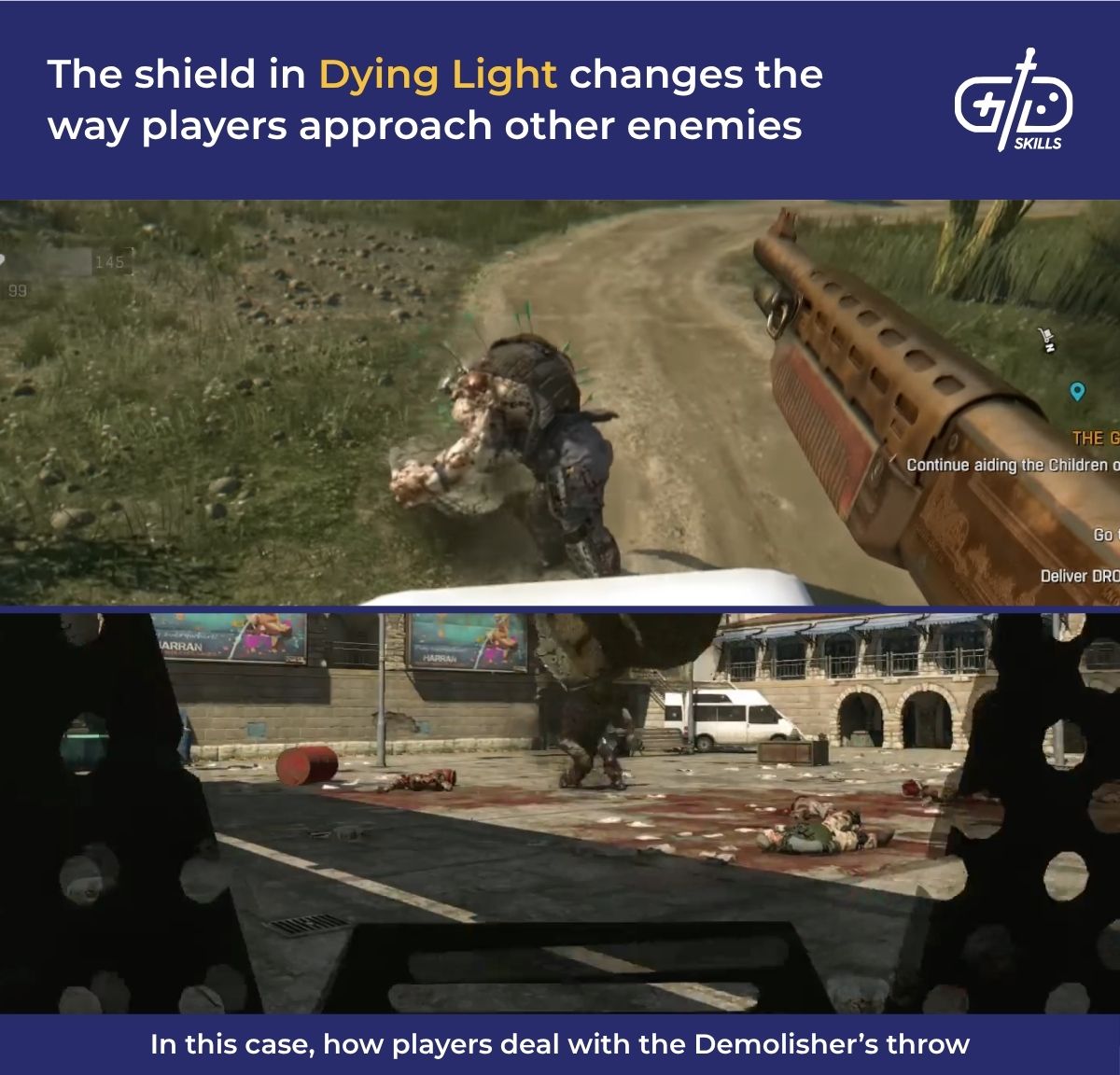
Cycles in the season, weather, or time of day are an option for making a map feel unique without modifying the environment at all. A change of season in open-world survival games asks players to prepare their resources and think about how to navigate the same environment but with less food and less survivable temperatures. On a shorter time scale, day and night cycles add a rhythm to gameplay which changes the pacing. The daytime is usually much safer in such games, with the nighttime bringing predators and creatures that freely attack the player, such as in The Forest. Stealth games flip the idea on its head, where the player themselves becomes the predator in the darkness.
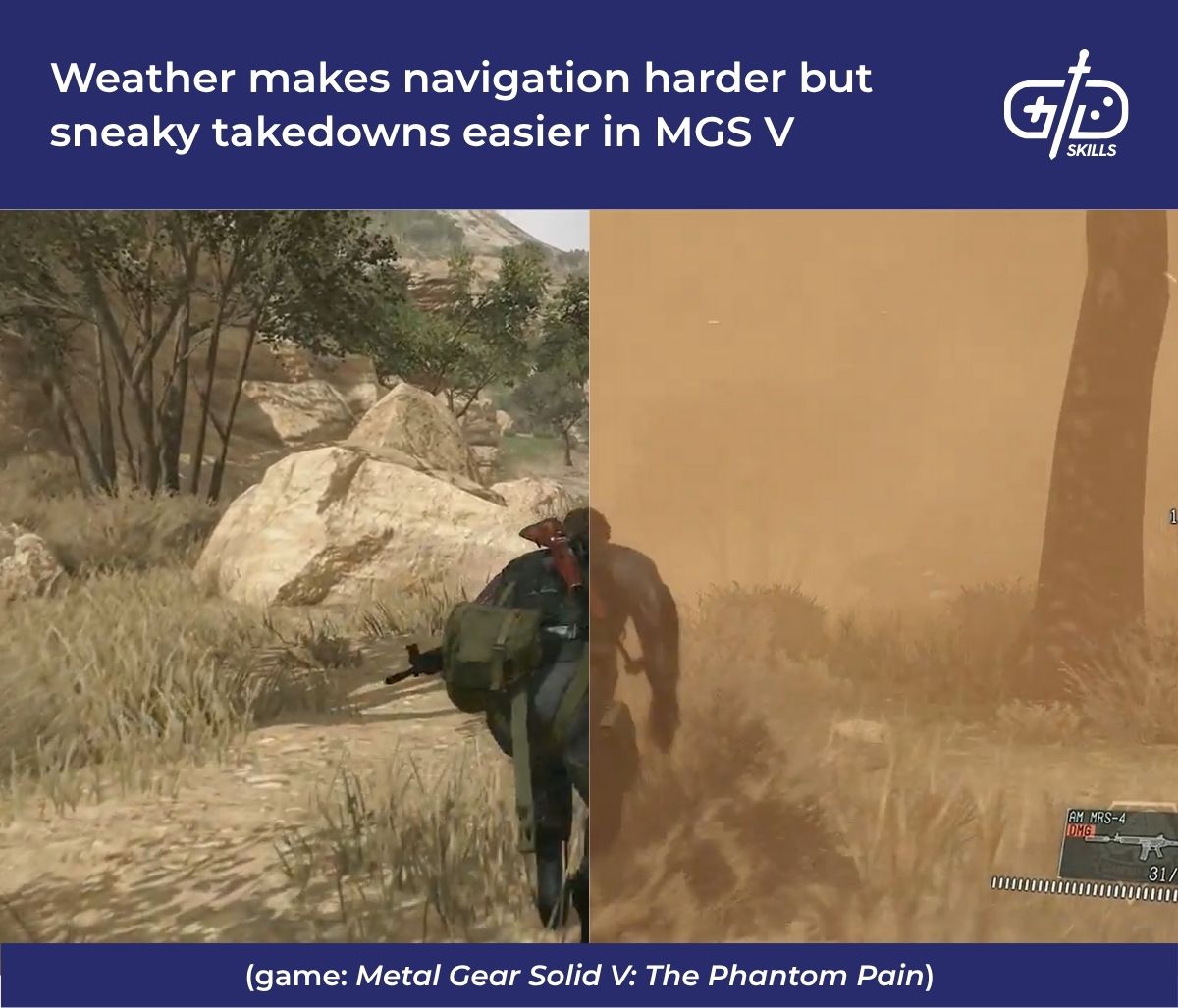
4. Design for visibility and discovery
Design for visibility and discovery since the player needs guidance in an open-world game. Even a completely open-world like Minecraft has an intended progression: the player starts aboveground, and they only venture into the more dangerous but resource-heavy caves later. A player spends their time traveling between interesting points, so an open-world uses the story and visual design to guide a player to those locations.
Method one for drawing players to areas is using the narrative. Having a quest or story beat draw the player to a location isn’t as organic as giving players free reign to explore. However, a linear experience gives players more context than free exploration. Red Dead Redemption 2 is a game that’s successful with a free open-world but linear, curated missions. Giving a quest and dropping a marker is a direct way to make locations “visible” to the player.
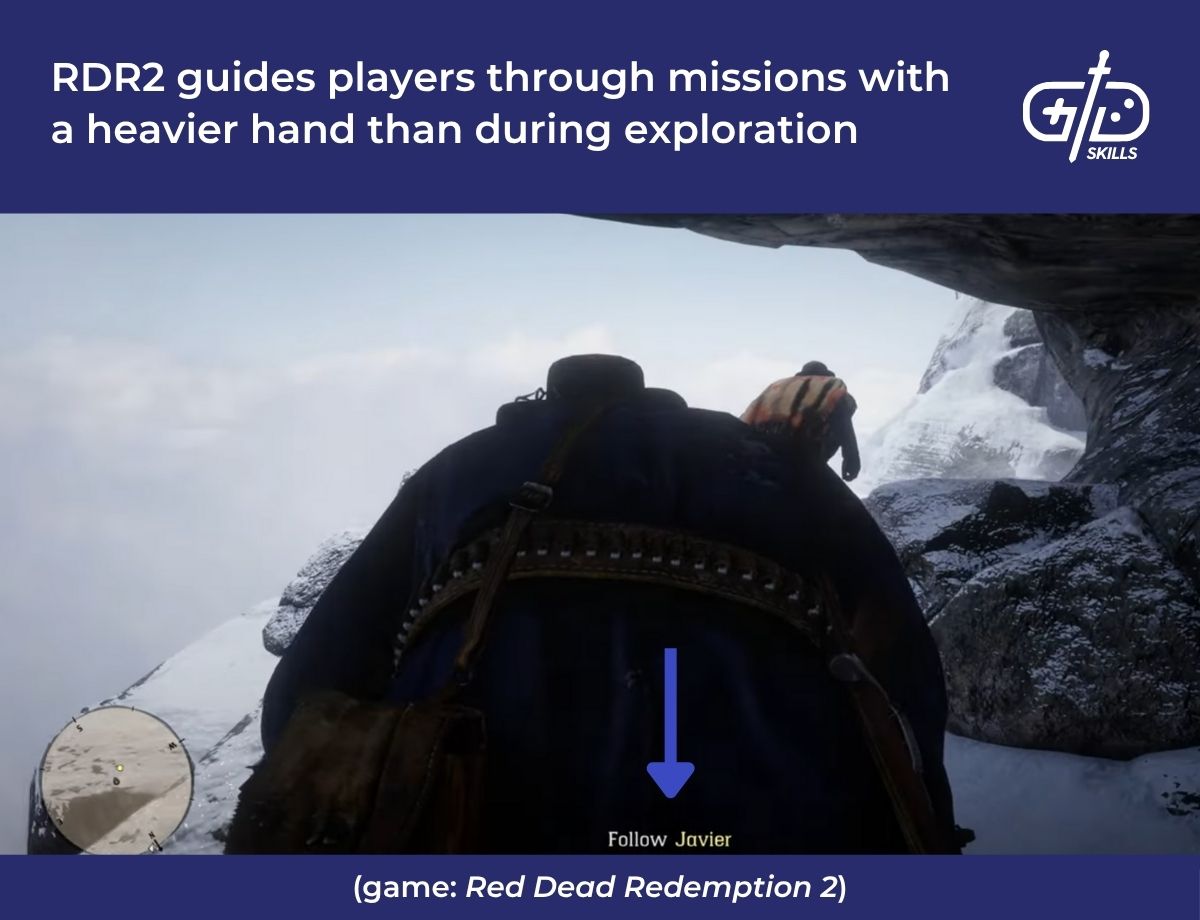
Open-world designers must think about how to draw in the player through visual design, though, as a significant portion of the gameplay is still exploration. Even games without an overt story are able to lead the player through solid design. Elden Ring is an effective example because so many points of interest are visible from exiting the tutorial: the crumbling structure with the next site of grace closeby, the castle where the first boss is, and the Erd Tree in the background. The game doesn’t rely on the beams that sprout from Sites of Grace to guide the player.
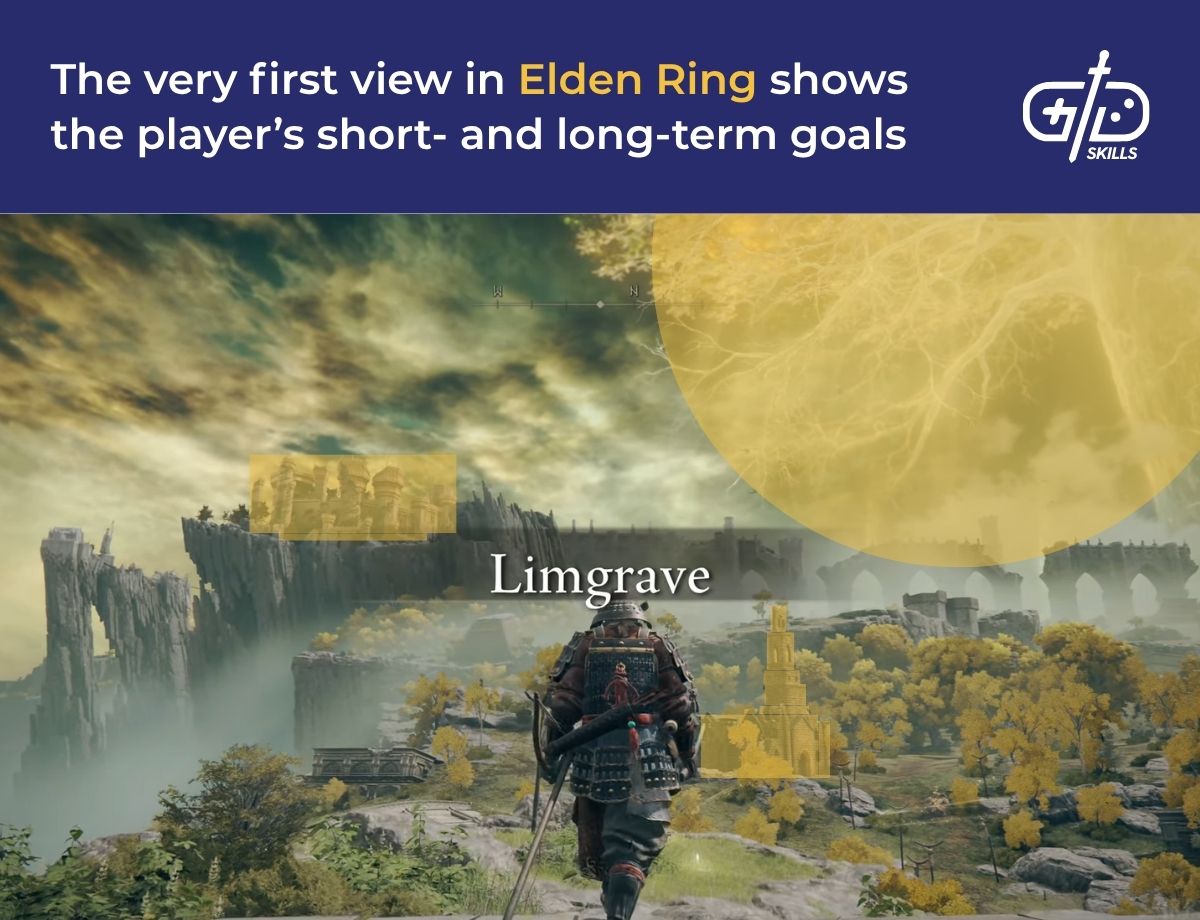
A great design tells the player what to expect out of a POI. Ghost of Tsushima is again an example of effective visual design. The color of smoke on the horizon immediately tells the player whether safety or danger is ahead. White smoke means a hotspring, where the player’s able to increase their health, or a camp the player has liberated from Mongol control, signalling a place the player wants to go with the same visual language. Black smoke means an active Mongol camp, an opportunity for the player to engage in more intense stealth and combat.
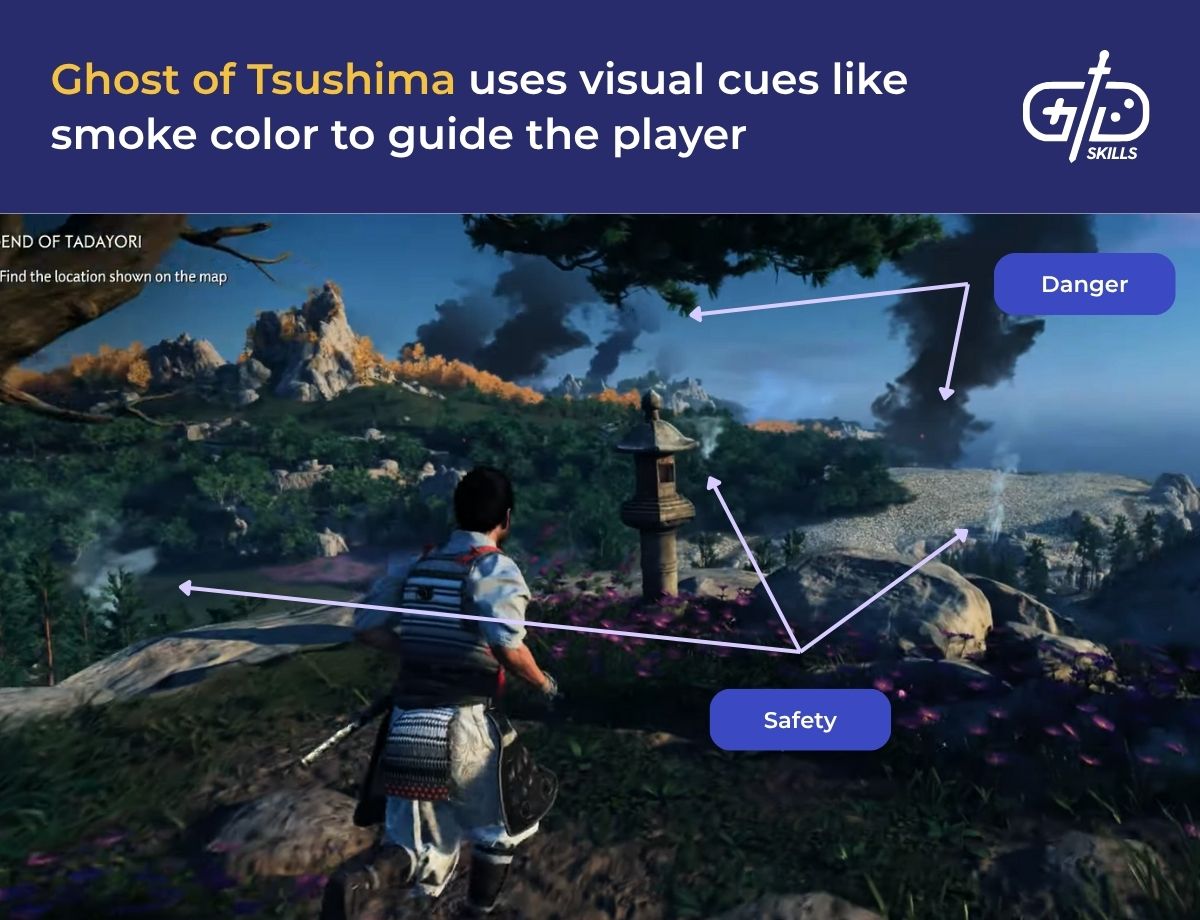
A challenge to open-ended approach is the player chancing on unintended ways of getting in while thinking they’re intentional. An open-ended solution means some players are going to miss something, which works in an open-world game unless a player must learn a specific concept. An example from a linear game is Portal. The game dealt with a very novel concept: the player is able to place portals that allow them to travel through one surface and come out another. An open-ended puzzle in such a game gives them agency but risks the player not learning the lesson they needed to. The game’s earliest puzzles have one solution to ensure players learn the basic tricks before allowing alternate paths to the end.
5. Use natural and artificial world dividers
Use natural and artificial world dividers appropriately to keep the player immersed in the game. Dividers keep players within the playable space and gate progress through the world. An unlimited open-world is off the table other than with complete procedural generation, so designers need to think about the eventuality that players will try to get past the edge of the world. Natural dividers are better because they signal to the player a clear boundary, but there are uses for artificial, “gamey” walls.
Dividers have a part to play in motivating players to continue exploring. A whole world with no boundaries is overwhelming and leaves it up to the player to work to find the fun. The world in the Witcher 3: Wild Hunt is for the most part open, but exploration of Skellige is tied to main quest progression. Exceptions to the rule are games like Minecraft, where the complete unrestricted freedom of exploration is the selling point. Procedurally generated terrain is the only feature that makes the lack of restriction possible, though.
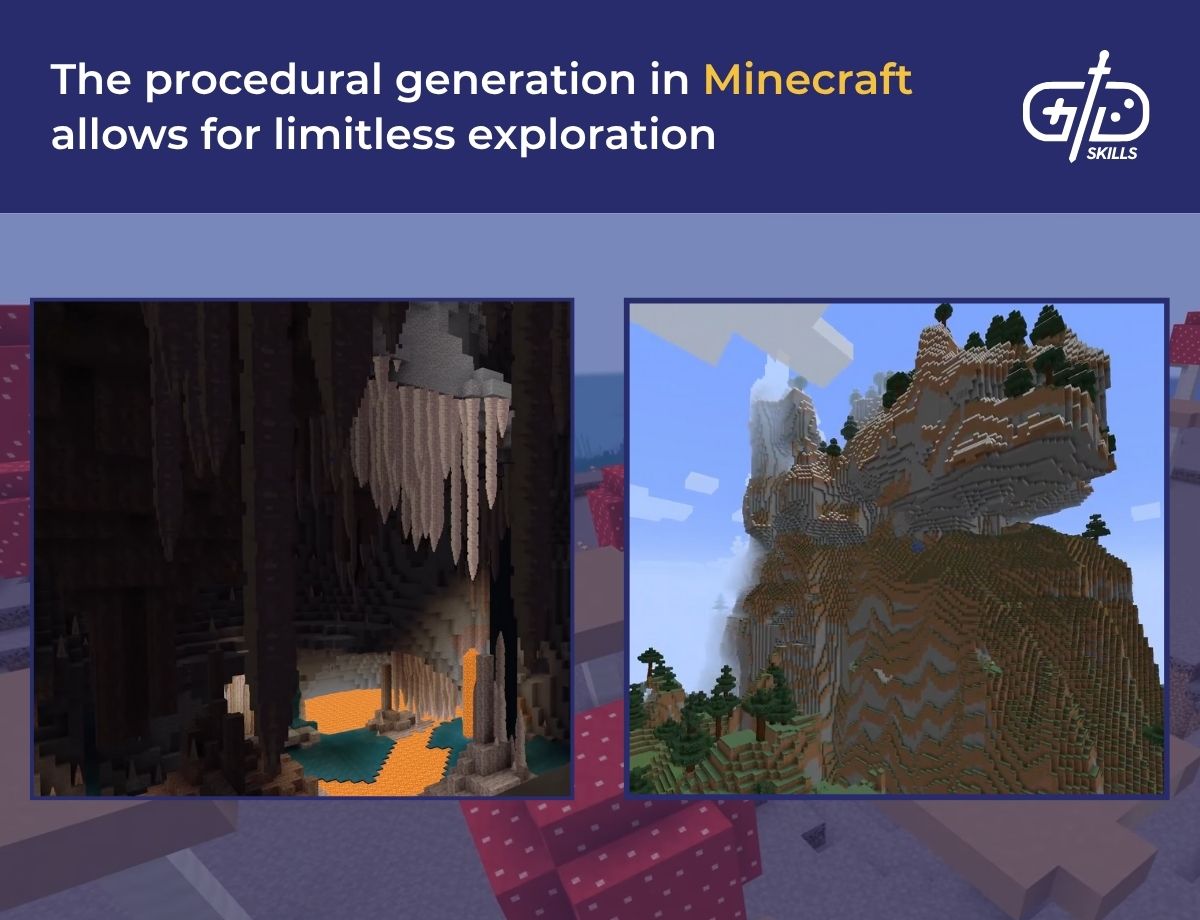
Natural and artificial world dividers serve the same purpose in hemming the player into the playable area or locking progress so exploration occurs at a set pace. The difference is in how obvious the divider is to the player. An artificial obstacle doesn’t hide the fact the game is a game: an invisible wall stops the player from progressing for no clear reason other than the fact the designers didn’t want them to go that way. Bethesda’s games since Oblivion stop the player and give them a message on reaching a world boundary: “You can’t go that way”.
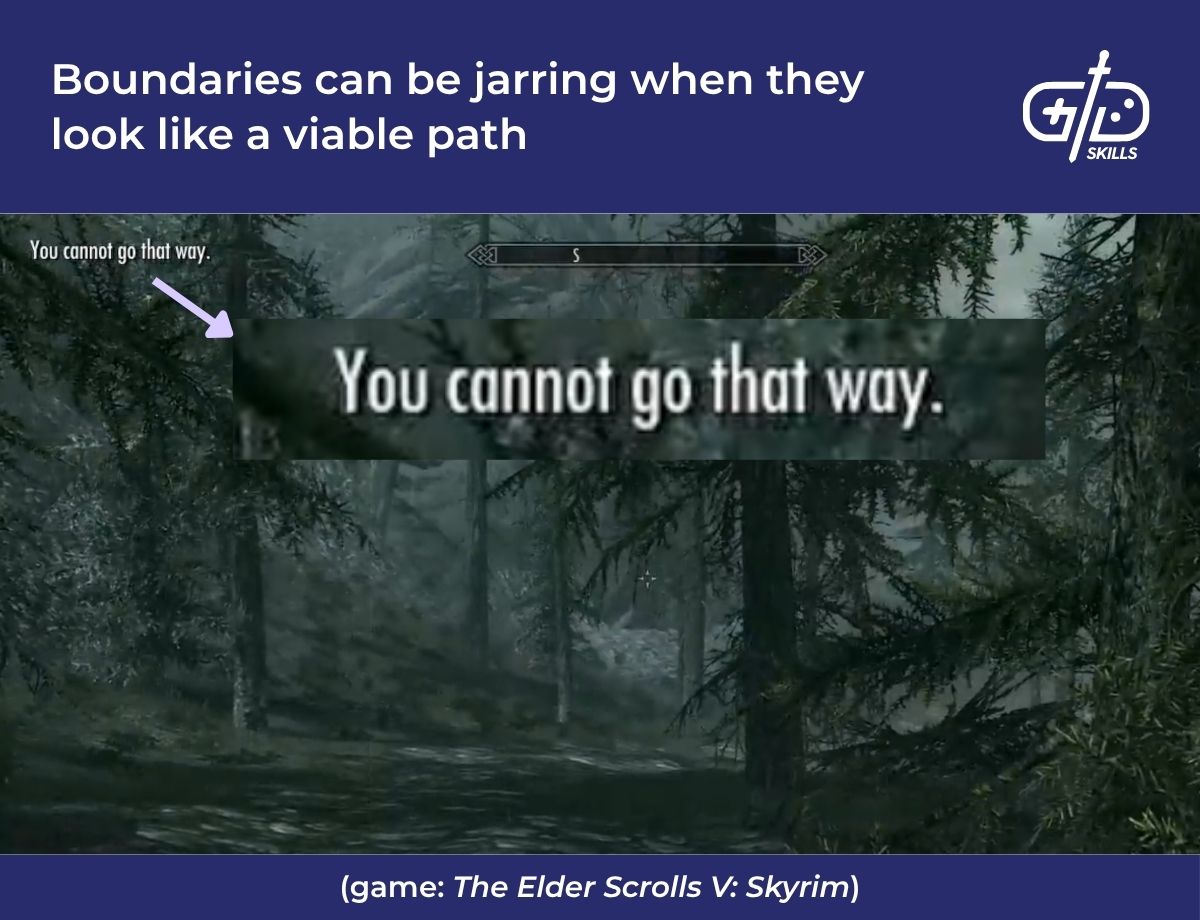
A natural obstacle signals more clearly to the player the reason there’s no way to continue. Natural obstacles include mountains, bodies of water, locked gates, or the space between planets in a space exploration game. Natural obstacles give players an opportunity to change the world space. Maybe a boat becomes available to cross the lake, or maybe a path through the mountains opens up in summer.
Natural obstacles prevent the frustration of exploring just to find an invisible wall. Playing on an island like in GTA hems in the player with water, making it clear where the edge of the play space is. The game also kills the player with sharks to prevent them from getting too far out. Letting the player swim forever is problematic because by the time they realize there’s nothing out there, they need to swim back for an incredibly long time. A world on land like Batman: Arkham City still takes a similar approach to restricting the player. The game takes place in a ghetto set aside for criminals, so getting shot down when trying to leave makes sense within the world already and sends a clear message not to go that way.

Natural barriers are the best, but invisible barriers are a necessary evil. A designer isn’t able to model the entire world, and there’s always a possibility of the natural barrier not successfully stopping the player. Aligning extra invisible protections with or just beyond natural barriers prevents more stubborn players from getting somewhere unintended.
6. Utilize the player verbs in the space that encourage exploring
Utilizing the player verbs in the space that encourage exploring means having a clear idea of what the player’s able to do before designing the world. Form follows function. A world where players are able to fly looks different than ones where they’re able to drive, for example.
Finding out the types of verbs and exploration depends on the experience. Red Dead Redemption lets players live out life as an old west outlaw. Grand Theft Auto lets players live life as a criminal in a modern city. Each experience comes with things a player is likely to do in turn. An outlaw rides horses, robs trains, and lives a self-sufficient life, crafting much of what they need. A player in GTA has access to many of the activities of modern life – in addition to crimes similar to the ones already mentioned: players walk, drive, swim, bike, and pilot their way around the game world.
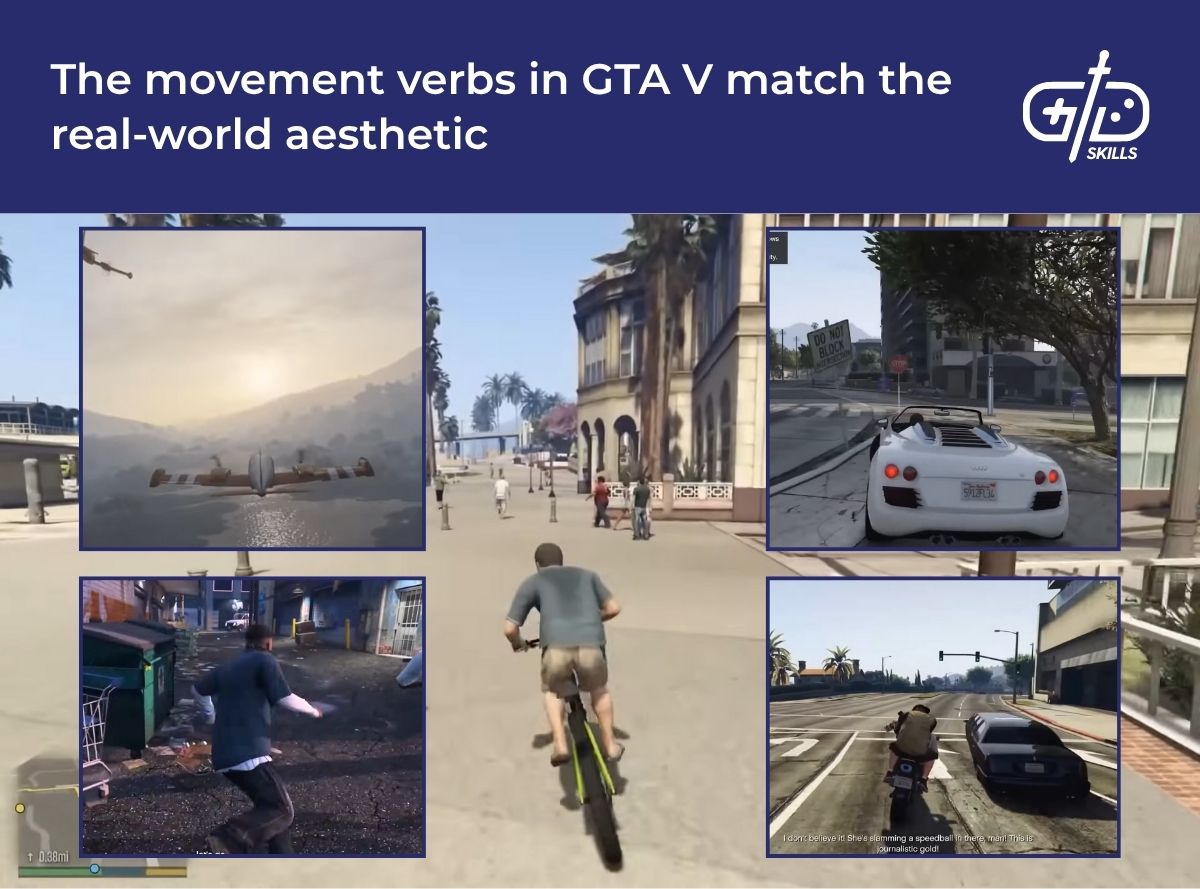
A designer that has verbs in mind is then able to create a variety of locations and terrains for the player to navigate. Horizon Forbidden West, to continue a previous example, contains the ability to ride walking and flying creatures. The designers place many Greenshine Slabs, materials used for upgrading equipment, at mountain peaks and out of reach areas. The new ability opens the way for players to get new materials and explore new areas. Flying opens up new quests as well: the Tides of Justice quest asks the player to search the sea for raiders, a task previously impossible without the ability to fly.
7. Handle fast travel
Handle fast travel because extended travel times without interesting challenges or rewards is unengaging. Players are likely to backtrack eventually in an open-world, so fast travel accounts for this inevitable problem. Fast travel works the same way in most games, letting players skip to a location after a brief loading screen, but a number of strategies are used to limit the ability.
The favored approach is to unlock fast travel to a location after discovering it. Walking, running, driving, or swimming without anything to do other than move forward is boring. Fast travel maximizes gameplay and minimizes unengaging travel time. Fast travel from the map usually isn’t an unlimited feature in such games. Players must do some exploration, otherwise it’s the same as a game like Demon’s Souls, a hub which leads to individual levels in any order. Players in Skyrim aren’t able to fast travel within underground locations or hostile encounters, for example. The game solves the backtracking problem in these areas by placing a tunnel at the end leading back to the entrance for especially large dungeons. In Dark Souls, the player is only able to fast travel to a fraction of the bonfires they’ve discovered, requiring the player to face some challenges repeatedly.
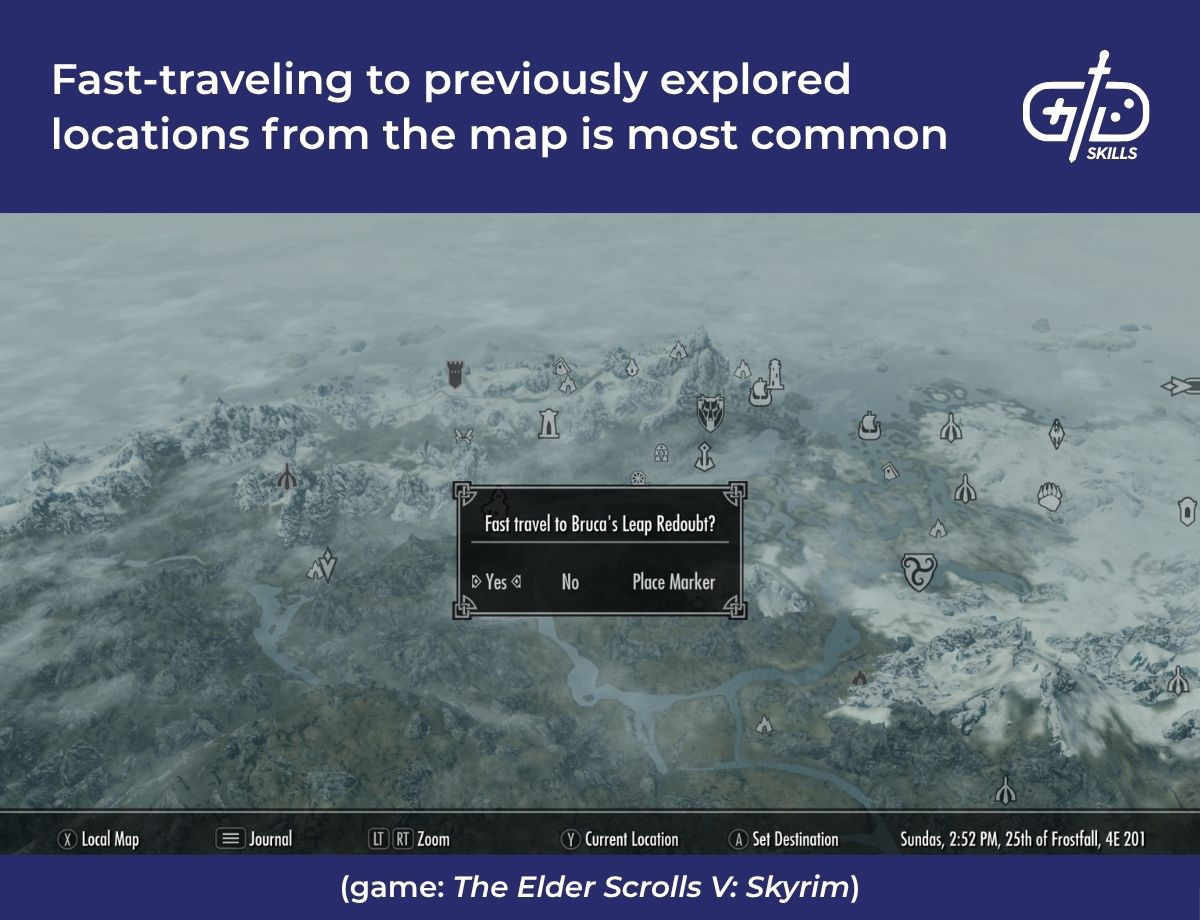
Doing away with a fast travel feature on the map and instead limiting it to in-game transportation options is less common and comes with a few pitfalls. Limited fast travel increases the chances a player needs to walk or take a less-than-ideal route to get between content. Relying on public transport and magic to get around in The Elder Scrolls 3: Morrowind works until the player is far from town and out of scrolls. An interesting movement verb is also necessary to make the experience of traveling fun. Players of Marvel’s Spider-Man skip the fast travel feature just so they’re able to swing around New York. Morrowind doesn’t have a similarly fun movement verb to support the walk from town to country, except the restricted levitate ability.
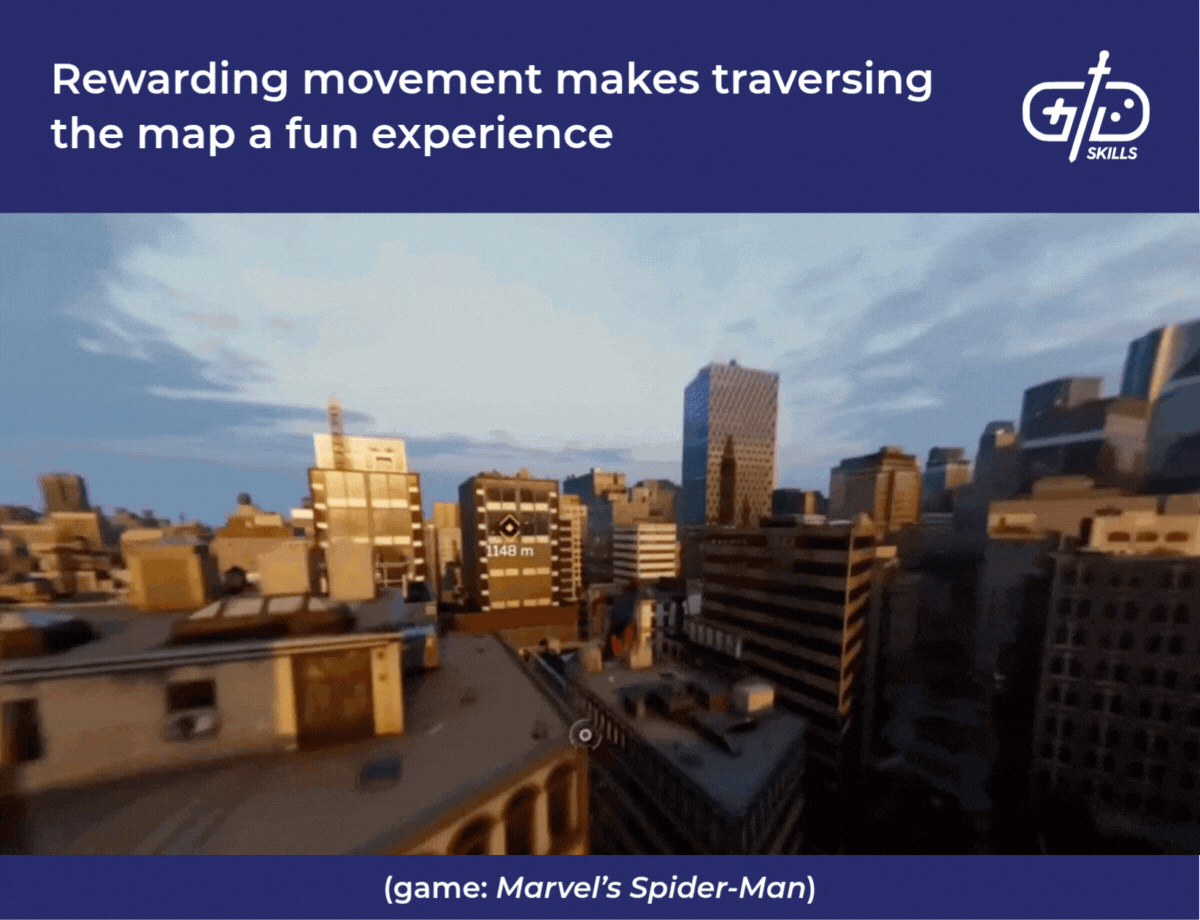
8. Use environmental storytelling and thematic consistency
Use environmental storytelling and thematic consistency, which both make the world feel alive. The world has a set of internal rules the player is able to learn which makes it feel big and complex, and therefore worth exploring. The first strategy, environmental storytelling, is the way small stories emerge from the cities, towns, wildernesses, and dungeons of the game. The second strategy, thematic consistency, is a sense that the different parts of the game contribute to a central message and feeling.
A living world that goes on without the player around comes together through moments of environmental storytelling. Environmental storytelling is using the visuals, sounds, and mechanics themselves to tell a story. The environment isn’t separate but supplements and reinforces the overt story told through dialogue, major events, and battles.
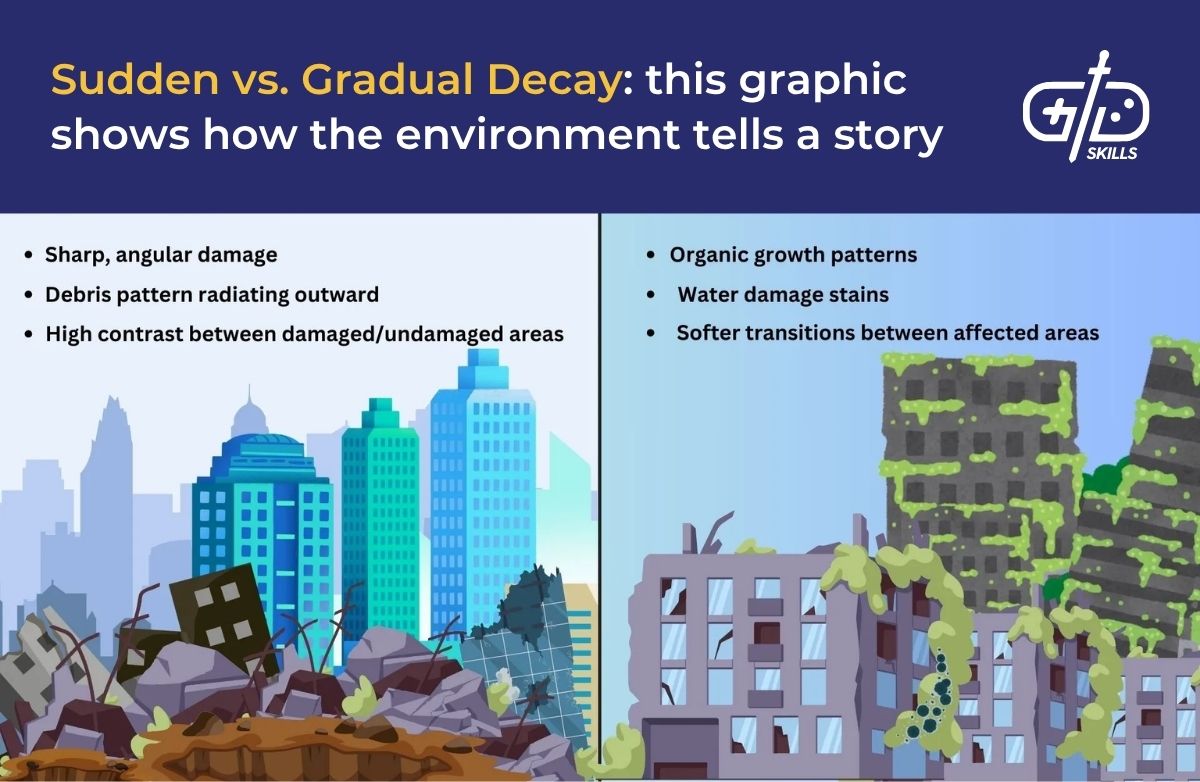
Embedded environmental storytelling is the first strategy for making a world feel alive. Embedded storytelling consists of pieces placed by designers. Dialogue between NPCs, the placement of objects in the environment, and small side adventures contribute to a lively world. Mini stories happening all around the player also give the impression that their experience with the world is only the tip of the iceberg. Players in Persona 5, for example, engage in many side activities between dungeon-crawling: throwing darts, going out to eat, playing sports, going to the bath house, getting a part-time job, or going to the movies.

Emergent environmental storytelling refers to the stories players create for themselves in the world. Systemic game design encourages these stories. A player in Breath of the Wild has a number of systems to interact with: setting fires, using the paraglider, attacking enemies. The possibilities are up to the player: perhaps the player sets a fire, uses its updraft to fly up with a paraglider, then swoops down to attack from above. It’s an epic story the player will remember since it’s a story they created.
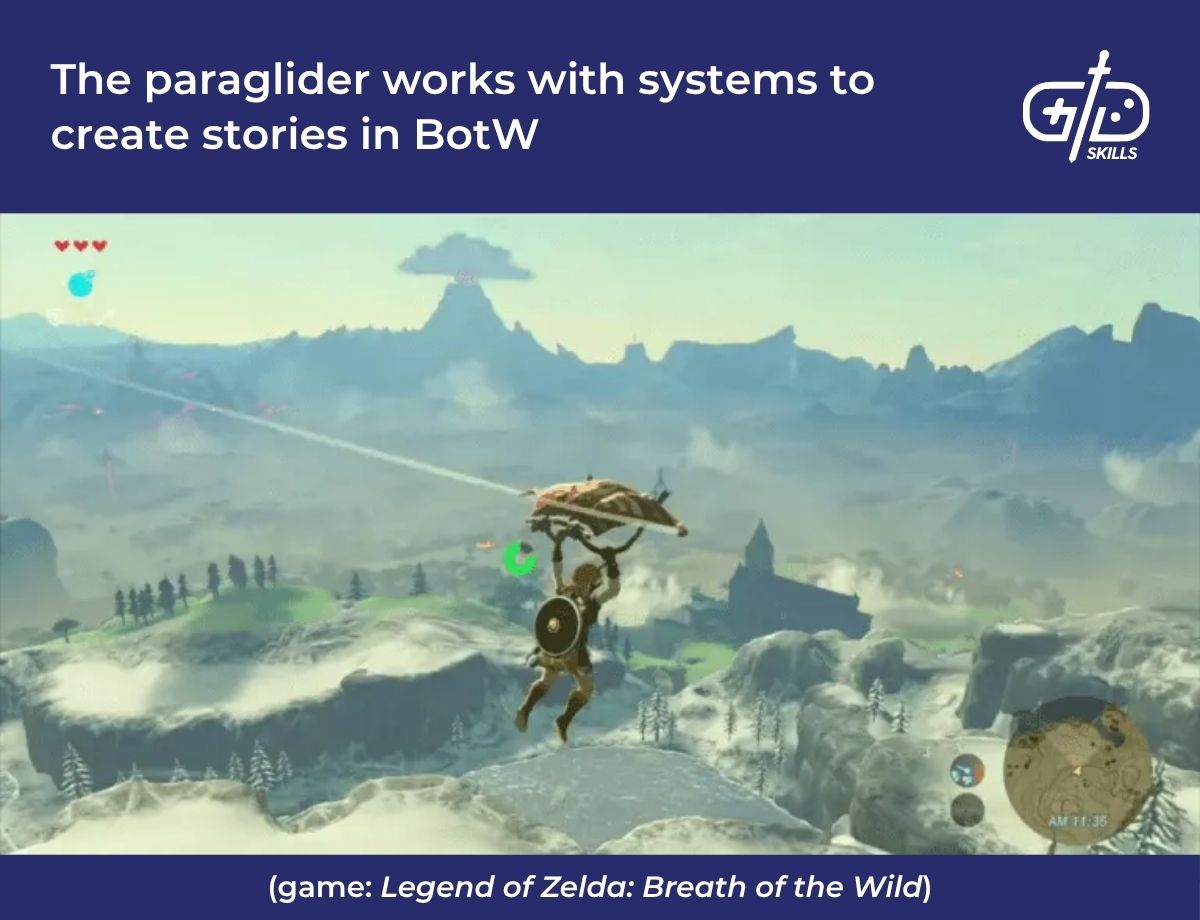
Thematic consistency makes the world sellable. The game sticks to the tone and messaging that’s presented through worldbuilding, environmental storytelling, visuals, plot, and the gameplay. Red Dead Redemption 2 is a game where these elements work together effectively to fulfil the fantasy of being an outlaw trying to survive in the wild west. The main story missions take players through the kinds of activities an Old West outlaw does to support their gang: hunting, robbing trains, buying and selling horses, and collecting debts. The open-world beyond missions is full of hostile bounty hunters, frontier towns, saloons, and trains which the player is free to rob as they please.
The details of Red Dead 2’s simulated world work with the activities to not just simulate but immerse the player in the life of an outlaw. Owning a horse is about more than transportation, for example. The process involves grooming, feeding, customizing their tack, and building the bond to make sure they keep their composure in combat. The slowed-down processes make the game feel grounded in reality, and the simulation continues beyond caring for horses. Players must skin and cook wild game before eating. Looting requires ruffling through fallen enemies’ pockets and opening cabinets. A game with a lighter and less gritty tone can get away with less detail, but Rockstar leverages their resources to create an experience that begins from the smallest elements.
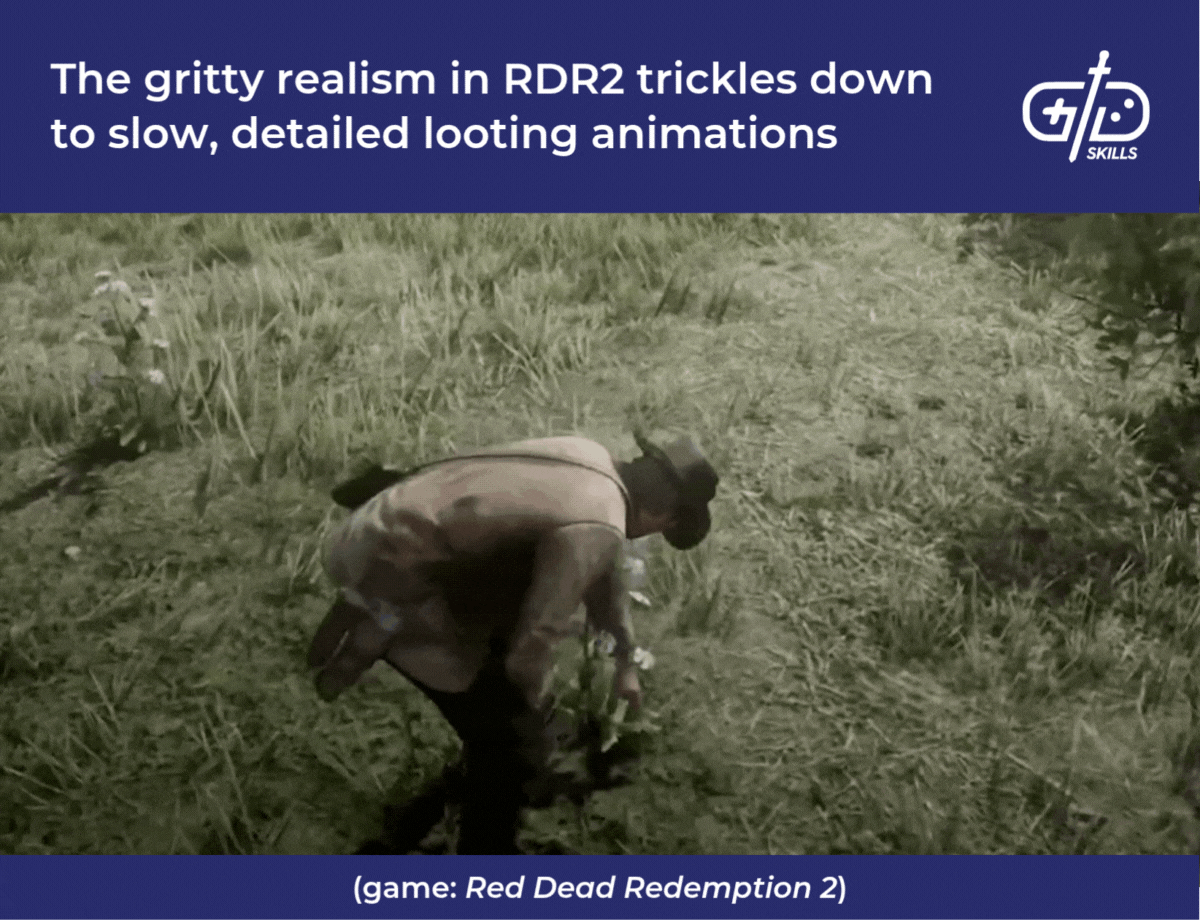
Using environmental storytelling and thematic consistency means having a consistent internal logic, in other words. Each piece of art, each game mechanic, and each hill in the terrain has a reason for being in the game. Not thinking about why the parts of an environment go together runs the risk of different parts of the game feeling dissonant. The Dragonborn in Skyrim starts as a nobody prisoner, but they are granted abilities beyond virtually any other inhabitant of the world almost immediately. The fantasy and the story are at odds in that case.











